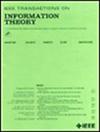Divergence Maximizing Linear Projection for Supervised Dimension Reduction
IF 2.2
3区 计算机科学
Q3 COMPUTER SCIENCE, INFORMATION SYSTEMS
引用次数: 0
Abstract
This paper proposes two linear projection methods for supervised dimension reduction using only first- and second-order statistics. The methods, each catering to a different parameter regime, are derived under the general Gaussian model by maximizing the Kullback-Leibler divergence between the two classes in the projected sample for a binary classification problem. They subsume existing linear projection approaches developed under simplifying assumptions of Gaussian distributions, such as these distributions might share an equal mean or covariance matrix. As a by-product, we establish that the multi-class linear discriminant analysis, a celebrated method for classification and supervised dimension reduction, is provably optimal for maximizing pairwise Kullback-Leibler divergence when the Gaussian populations share an identical covariance matrix. For the case when the Gaussian distributions share an equal mean, we establish conditions under which the optimal subspace remains invariant regardless of how the Kullback-Leibler divergence is defined, despite the asymmetry of the divergence measure itself. Such conditions encompass the classical case of signal plus noise, where both signal and noise have zero mean and arbitrary covariance matrices. Experiments are conducted to validate the proposed solutions, demonstrate their superior performance over existing alternatives, and illustrate the procedure for selecting the appropriate linear projection solution.求助全文
约1分钟内获得全文
求助全文
来源期刊

IEEE Transactions on Information Theory
工程技术-工程:电子与电气
CiteScore
5.70
自引率
20.00%
发文量
514
审稿时长
12 months
期刊介绍:
The IEEE Transactions on Information Theory is a journal that publishes theoretical and experimental papers concerned with the transmission, processing, and utilization of information. The boundaries of acceptable subject matter are intentionally not sharply delimited. Rather, it is hoped that as the focus of research activity changes, a flexible policy will permit this Transactions to follow suit. Current appropriate topics are best reflected by recent Tables of Contents; they are summarized in the titles of editorial areas that appear on the inside front cover.
 求助内容:
求助内容: 应助结果提醒方式:
应助结果提醒方式:


